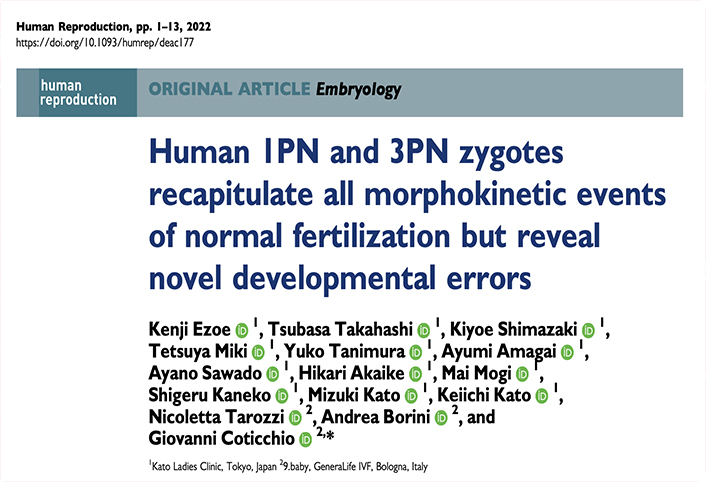
Kenji Ezoe , Tsubasa Takahashi, Kiyoe Shimazaki, Tetsuya Miki, Yuko Tanimura, Ayumi Amagai, Ayano Sawado, Hikari Akaike, Mai Mogi, Shigeru Kaneko, Mizuki Kato, Keiichi Kato, Nicoletta Tarozzi, Andrea Borini, Giovanni Coticchio
Human Reproduction, pp. 1–13, 2022 – Aug 11;deac177. https://doi.org/10.1093/humrep/deac177
Abstract
- Study question: Does mono- (1PN) and tri-pronuclear (3PN) fertilization recapitulate the morphokinetic changes of normal bi-pronuclear (2PN) fertilization?
- Summary answer: Abnormal fertilization retraces the overall choreography of normal fertilization but reveals novel morphokinetic phenomena and raises scientifically and clinically relevant questions.
- What is known already: ART has allowed the extracorporeal observation of early human development. Time-lapse technology (TLT) has revealed the complexity of the morphokinetic changes underpinning fertilization and the importance of this process for the genetic and cellular integrity of the embryo. Abnormal fertilization has remained neglected, despite its relevance to the physiology and pathology of early human development.
- Study design, size, duration: This retrospective study involved TLT observation of normally (2PN, N = 2517) and abnormally (1PN, N = 41; 3PN, N = 27) fertilized oocytes generated in ICSI cycles performed between October 2019 and December 2020. Oocyte retrieval was carried out after clomiphene citrate-based minimal ovarian stimulation. Oocytes of patients with different diagnoses of infertility were included in the analysis, while cases involving cryopreserved gametes or surgically retrieved sperm were excluded.
- Participants/materials, setting, methods: The study included 1231 couples treated for diverse infertility causes. The fraction of male factor cases was substantial (36.1%). Microinjected oocytes were assessed by a combined TLT-culture system. Oocytes not suitable for TLT assessment, owing to an excess of residual corona cells or inadequate orientation for correct observation, were not analysed. Phenomena relevant to meiotic resumption, pronuclear dynamics, cytoplasmic/cortical modifications, cleavage patterns and embryo quality were annotated and compared between groups.
- Main results and the role of chance: Extrusion of the second polar body (PBII) was observed in almost all 2PN/1PN (99.9% and 100.0%, respectively) and in a vast majority of 3PN zygotes (92.1%). Rates of PBII fusion with the ooplasm were much higher in 1PN and 3PN zygotes (P < 0.0001 versus 2PN). The cytoplasmic wave was observed not only in 2PN and 3PN but also in 1PN zygotes (positivity rates of 99.8% and 100% and 82.9%, respectively; P < 0.0001). More rarely, 2PN and 1PN zygotes emitted a third polar body (PBIII). The average times of this event were comparable. The presence and position of the cytoplasmic halo were comparable among the three classes of zygotes. In the 1PN group, the single PN was maternally or paternally derived in 17 and 24 zygotes, respectively, while in the vast majority of 3PN zygotes (121/127) the supernumerary PN was of maternal origin. Average times of maternal PN appearance were comparable, while average times of paternal PN appearance were delayed in 3PN zygotes (P = 0.0127). Compared with the control group, the area of the maternal PN was larger in 1PN zygotes, but smaller in 3PN zygotes (P < 0.0001). The paternal PNs displayed the same trend (P < 0.0001), although such values were consistently smaller than maternal PNs. The area of the third PN in the 3PN group was on average more than 50% smaller than those of maternal and paternal PNs. In maternal PNs of 3PN zygotes, nucleolus precursor bodies (NPBs) aligned along the area of PN juxtaposition at a lower rate compared with the 2PN group. The rate of NPB alignment was ∼50% smaller in 1PN zygotes (P = 0.0001). In paternal PNs, the rates of NPB alignment were not statistically different among the three groups. Asynchronous PN breakdown was increased in 3PN compared with 2PN zygotes (P = 0.0026). In 1PN zygotes, a developmental delay was observed starting from the disappearance of the cytoplasmic halo, reaching 9 h at the time of the first cleavage (P < 0.0001). Higher rates of abnormal cleavage patterns and blastomere fragmentation (P < 0.0001) were observed in 1PN compared to 2N and 3PN zygotes. Cleavage progression was increasingly affected after abnormal fertilization, especially 1PN, finally resulting in blastocyst formation rates of 70.2%, 12.2% and 53.5% in 2PN, 1PN and 3PN embryos, respectively (P < 0.0001). Both maternal and paternal ages were higher in cases involving 3PN fertilization.
- Limitations, reasons for caution: The study data were obtained from ICSI, but not standard IVF, treatments carried out in a single centre. The study findings therefore require independent verification.
- Wider implications of the findings: This study reports the first detailed morphokinetic map of human abnormal fertilization. Collectively, this evidence prompts new scientific hypotheses and raises clinical questions relevant to the aetiology and the treatment of abnormal fertilization.
- Study funding/competing interest(s): This study was supported by the participating institutions. The authors have no conflicts of interest to declare.
- Trial registration number: N/A.
- Keywords: abnormal fertilization; blastocyst; embryo development; fertilization; polar body; pronucleus; time-lapse.